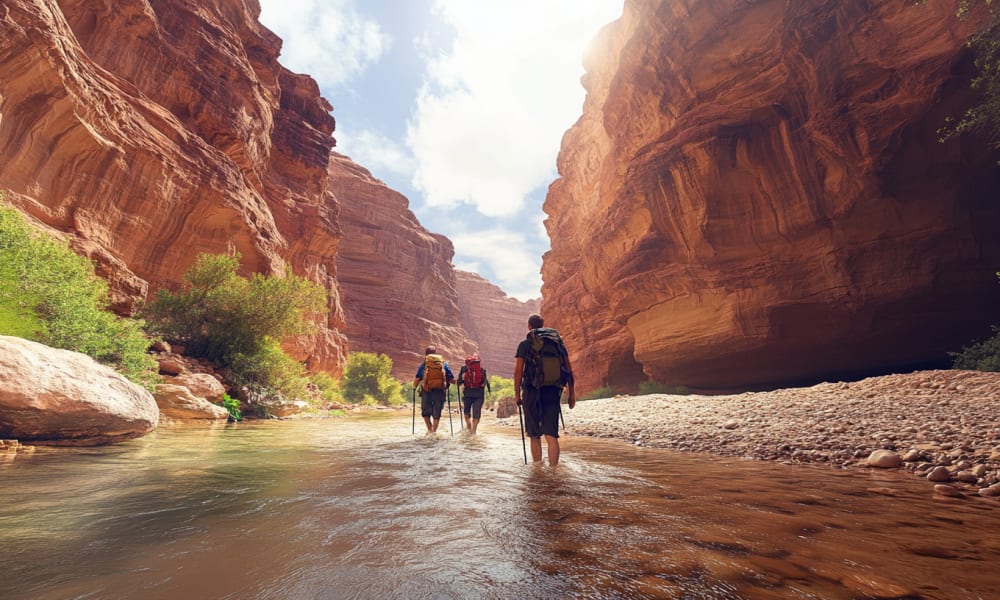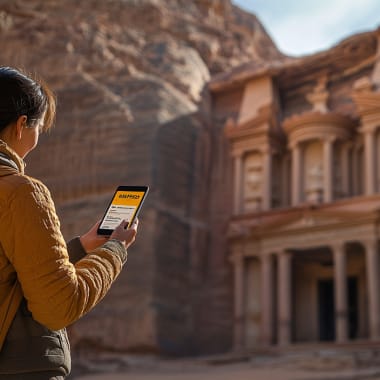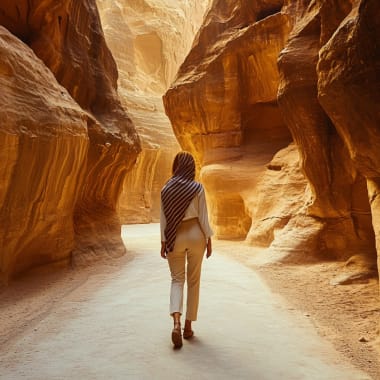
Outdoor Adventures in Jordan: Desert and Sea
Experience Jordan's wild side – between majestic desert and colorful underwater world.
Experience Jordan's wild side – between majestic desert and colorful underwater world.
Jordan is a country full of contrasts – between sand dunes and coral reefs, ancient rock landscapes and crystal-clear sea bays. Those who wish to discover the kingdom off the beaten cultural paths will find spectacular outdoor adventures that challenge both body and senses. Whether trekking through canyon gorges, camping under the starry sky, or diving in the Red Sea – Jordan surprises with natural experiences that leave a lasting impression. We present five extraordinary adventures that will make your trip unforgettable.
Hiking in Wadi Mujib
A canyoning adventure through Jordan’s most dramatic gorge
What makes this experience special
Wadi Mujib is a true natural wonder—and the lowest nature reserve on Earth. Stretching from 410 to 416 meters below sea level up to mountain peaks over 1,200 meters high, the area offers a striking vertical landscape of gorges, waterways, and sandstone formations.
Fed year-round by seven tributaries, the reserve is a paradise for hikers and canyoning enthusiasts. Its rare mix of water and rock creates a biodiverse haven that’s home to more than 300 plant species, wildcats, and a variety of migratory birds. Recognized for its ecological value, Wadi Mujib has been designated a UNESCO Biosphere Reserve since 2011.
What to expect on the trail
The most popular route is the Siq Trail, which starts at the Mujib Adventure Center. This two-hour adventure takes you deep into a narrow canyon where you’ll wade through rivers, scramble over rocks, and eventually reach a powerful waterfall—with the option to float gently back downstream.
For adrenaline seekers, the Canyon Trail and Malaqi Trail offer more intense experiences, including rappelling down 20-meter waterfalls. These guided routes range from 2 to 7 hours and require a higher level of fitness. For a more relaxed experience, the Ibn Hammad Trail follows a dry path with sweeping views of the Dead Sea and chances to spot wildlife like Nubian ibex.
Good to know before you go
The best time to hike Wadi Mujib is from April to October, as most trails close during the winter months. Spring and fall offer the most pleasant weather and ideal water levels.
Canyoning routes require solid fitness and surefootedness. For wet sections, bring sturdy water shoes and clothes that can get soaked. Life jackets and helmets are provided for guided tours.
All trails begin at the Mujib Adventure Center, located directly on the Dead Sea Highway. The easiest way to get there is by rental car or with an organized tour. While the Siq Trail can be explored independently, more challenging routes like the Canyon and Malaqi Trails require certified guides.
Desert Camping in Wadi Rum
Between sandstone giants and starlit skies—experience the magic of Jordan’s desert
What makes this experience special
Wadi Rum in southern Jordan feels like a world apart: towering red sandstone cliffs, vast valleys, natural rock bridges, and deep canyons create a surreal desert landscape known fittingly as the "Valley of the Moon." Formed over millions of years by wind and water erosion, Wadi Rum is one of the country’s most awe-inspiring natural wonders.
But this desert is more than just a backdrop. It's home to the Bedouins, who have lived here for centuries and continue to honor their traditions. Their lifestyle—rooted in hospitality, simplicity, and harmony with nature—is something visitors can experience firsthand. Wadi Rum has also made its mark on Hollywood, with films like The Martian and Lawrence of Arabia shot on location. As a UNESCO World Heritage Site and part of Jordan’s "Golden Triangle" alongside Petra and Aqaba, it offers a rich blend of natural beauty, cultural depth, and adventure.
What to expect on your stay
Your time in Wadi Rum typically begins with a jeep tour through its Mars-like landscape. Half-day or full-day excursions take you to dramatic landmarks like the Burdah Rock Bridge and Khazali Canyon, often wrapping up with a golden sunset over the dunes.
Thrill-seekers can try rock climbing on sandstone walls or sandboarding down the soft dunes. For a slower pace, camel rides offer a traditional and peaceful way to explore the terrain. And when night falls, the desert sky steals the show: a brilliant canvas of stars unmarred by light pollution. At the camps, you’ll be treated to authentic Bedouin dishes like Zarb—meat and vegetables slow-cooked underground—along with campfire music and storytelling under the stars.
Good to know before you go
Wadi Rum offers a wide range of accommodations, from simple Bedouin tents to luxury glamping experiences with en-suite bathrooms and panoramic domes.
Getting there is easy: it’s about a one-hour drive from Aqaba or two hours from Petra. Many camps offer shuttle transfers, and taxis or rental cars are also good options. Just keep in mind: there’s no public transportation to Wadi Rum, so plan your arrival and departure in advance to avoid any hiccups.
Diving in the Red Sea at Aqaba
Colorful coral reefs and sunken treasures in Jordan’s underwater world
What makes this experience special
The waters off Aqaba are home to some of the most spectacular dive sites in the Red Sea. With over 200 species of coral and more than 1,000 species of fish, this vibrant marine ecosystem offers a level of biodiversity that few other places can match—plus crystal-clear visibility reaching up to 60 meters.
What sets Aqaba apart is the mix of natural reefs and purposefully sunken wrecks. Under the initiative of King Abdullah II, several objects—including the famous Cedar Pride shipwreck and a decommissioned C-130 Hercules aircraft—have been sunk to create artificial reefs. Combined with the unusually salty waters of the Gulf of Aqaba, which support even more marine life, these sites make Aqaba a truly unique diving destination.
What to expect underwater
A dive at the Cedar Pride wreck is a must. Once a cargo ship, it now rests on the seafloor fully encrusted with coral and swarming with marine life. Nearby, the sunken Hercules aircraft has become a magnet for underwater photographers. For more relaxed reef dives, head to the Japanese Garden or the Salad Coral Gardens, where sea turtles and eagle rays are frequently spotted.
Aqaba is also ideal for beginners. Many dive sites are easily accessible from shore, and local dive centers offer introductory dives and PADI certification courses. Not ready to dive in? Shallow reefs near the coast are perfect for snorkeling, offering equally stunning underwater views without going deep.
Good to know before you go
Aqaba is a year-round diving destination, but the best months are May, June, September, and October, when water temperatures are warm, visibility is excellent, and the sea is calm. During winter, the water can cool to around 68°F (20°C), but diving remains possible with the right wetsuit.
Whether you’re a seasoned diver or a first-timer, you’ll find plenty of trusted dive centers in Aqaba offering equipment rentals, guided tours, and professional instruction.
Trekking the Jordan Trail
A long-distance hike through Jordan’s history and natural diversity
What makes this experience special
The Jordan Trail is more than just a hiking route—it’s a journey through time, landscapes, and cultures. Spanning roughly 420 miles (675 kilometers), the trail stretches from Um Qais in the north all the way to the Red Sea coast near Aqaba, passing through lush forests, fertile valleys, rugged canyons, the rose-colored rocks of Petra, and the vast dunes of Wadi Rum.
What sets this trail apart is its deep cultural dimension: it connects over 75 villages and towns, winds through major historic sites like Jerash, Petra, and Mount Nebo, and offers intimate glimpses into rural Jordanian life. Overnight stays in homestays or Bedouin camps turn the trek into a deeply human experience. Unlike many traditional long-distance hikes, the Jordan Trail blends nature, history, and hospitality—offering a refreshing, crowd-free escape for those who seek meaningful travel.
What to expect on the trail
The most iconic section is the trek from Dana to Petra, which cuts through the stunning Dana Biosphere Reserve and finishes at the legendary rock-carved city of Petra. This stretch is considered one of the most beautiful parts of the trail—scenically diverse, culturally rich, and physically rewarding.
Whether you walk the entire trail or choose a section, you’ll experience the full spectrum of Jordan’s landscapes: the green hills of Ajloun, dramatic canyons near Wadi Mujib, the desert expanse of Wadi Rum, and finally the coastline at Aqaba. Along the way, community-run projects and homestays offer opportunities for authentic cultural exchange. Many hikers recall heartfelt conversations, shared meals, and the warm hospitality of locals as the true highlight of their journey. Guided treks are available and can greatly simplify logistics—especially in remote areas.
Good to know before you go
The best times to hike the Jordan Trail are in spring (March to May) and fall (September to November), when temperatures are mild and the landscapes—especially in the north and around Dana—are lush and vibrant.
Daily segments vary depending on the route and your fitness level but typically range between 9 and 15 miles (15 to 25 km). Some sections involve significant elevation changes and can be quite challenging. If you're not planning to hike the entire trail, you can opt for specific segments—like the Dana to Petra section, which takes about 4–5 days to complete.
Accommodation is available in homestays, Bedouin camps, and small lodges along the way. Independent hikers should plan their itinerary in advance, especially regarding food and water. For a more relaxed experience, guided tours include accommodations, meals, and luggage transport—ideal for those who want to focus on the hike without worrying about logistics.
Hot Air Balloon Ride Over Wadi Rum
Soar above Jordan’s majestic desert landscape in the glow of dawn
What makes this experience special
From above, the true magic of Wadi Rum reveals itself: endless red sand dunes, rugged rock formations, and vast valleys stretch out like a painted canvas beneath the balloon. Towering cliffs rise up to 1,500 meters, appearing even more dramatic from the air—especially when bathed in the soft light of early morning.
What makes this adventure so unique is the shift in perspective. While on-the-ground tours immerse you in the desert’s details, a balloon ride lets you take in the full scope of its geological wonders—from winding valleys to sweeping desert plains. The flight itself is smooth, quiet, almost meditative—a deeply immersive nature experience in absolute stillness. It’s no wonder Wadi Rum has served as the cinematic backdrop for movies like The Martian and Star Wars—from above, it feels like another planet.
What to expect on the flight
A typical flight begins before sunrise. Guests are picked up from their desert camp or the visitor center and transported to the launch site, where the crew prepares the balloon. After a short safety briefing, you’ll gently lift off—ascending up to 3,600 feet (around 1,100 meters). The flight lasts about an hour and ends with a soft landing and a light post-flight snack of tea, coffee, and local pastries.
During the ride, you’ll glide over one of the world’s most iconic desert landscapes: red dunes, wind-carved valleys, and towering rock formations glowing gold in the morning sun. The peaceful silence, dramatic lighting, and panoramic views make this experience unforgettable—whether you’re a photographer, romantic, or adventurer at heart.
Good to know before you go
The best season for a hot air balloon ride in Wadi Rum is from October through April, when temperatures are mild and wind conditions more predictable. Flights typically take place just before sunrise to make the most of the stunning morning light and calmer air.
Since ballooning is highly weather-dependent, flights may be canceled or rescheduled on short notice due to strong winds, sandstorms, or rain.
Professional operators like Rum Balloon and the Royal Aero Sports Club of Jordan ensure a high standard of safety. Pilots are certified, the equipment is regularly maintained, and guests receive a thorough safety briefing before takeoff.
Adventures That Stay With You
Whether you’re floating high above the dunes, diving deep below coral reefs, or trekking through wild canyons—Jordan offers outdoor experiences as diverse as its landscapes. These adventures take you beyond the expected and into the heart of the country’s raw, natural beauty. If you’re ready to discover Jordan at its wildest, these are the moments that will stay with you long after the journey ends.
Discover the Orient with experts who have explored every corner themselves
Your dream holiday, tailor-made by experts.
We don't just know the Middle East from books, we visit the country several times a year to experience the culture, landscape and people first-hand.
From your first enquiry to your return home, we are there for you personally - by phone, email or WhatsApp, whenever you need us. Our trips are as unique as you are: individually planned and provided with exclusive privileges and high-quality arrangements that will make your trip unforgettable.
Experts for your Orient trip







